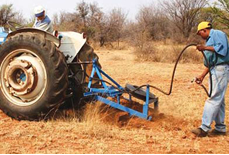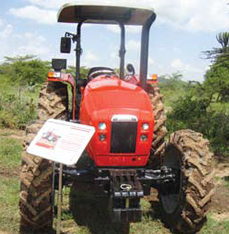Mechanisation: Minimising Your Costs
 Properly maintained, a good secondhand tractor will give its new owner years of service. Have big-ticket used machinery checked by someone competent to spot problems and ask the right questions. Once the tractor is yours make daily checks part of the routine operating procedure for the operator.
Properly maintained, a good secondhand tractor will give its new owner years of service. Have big-ticket used machinery checked by someone competent to spot problems and ask the right questions. Once the tractor is yours make daily checks part of the routine operating procedure for the operator.
It is both difficult and unwise to cut corners if you have to plant high-quality seed and make sure they receive proper irrigation. But mechanisation costs are often unnecessarily high and looking at these again could result in lower input costs and higher profits.
- The profit in a cash crop venture is determined by crop yield and input costs.
- The higher the yield, the higher the profit for a specific input cost.
- The lower the input cost for a specific yield, the higher the profit.
- The farmer’s efforts should therefore be focused on increasing yield and/or decreasing input costs.
- Increased yields can be achieved by using superior cultivars and optimum fertilisation and irrigation levels.
 Remember that all these measures add to the input costs and that the extra yield should be worth more than the extra input cost to increase profit. If the best possible cultivar is planted and fertilising is already at an optimum, profit can be maximised by lowering input costs. It should be obvious that savings should not be made on seed cost by buying cheaper, inferior cultivars or by decreased fertilisation levels. What remains is mechanisation cost. This article looks at ways to reduce mechanisation costs.
Remember that all these measures add to the input costs and that the extra yield should be worth more than the extra input cost to increase profit. If the best possible cultivar is planted and fertilising is already at an optimum, profit can be maximised by lowering input costs. It should be obvious that savings should not be made on seed cost by buying cheaper, inferior cultivars or by decreased fertilisation levels. What remains is mechanisation cost. This article looks at ways to reduce mechanisation costs.
Mechanisation System
The farmer should consider whether all current operations are really necessary and consider reducing them by changing the overall mechanisation system. It may be best to get an expert to help you with this.
Correct Tractor/Implement Matching
Tractors have specific power capabilities and implements have specific draught requirements to function properly in different soils. It is important to match the right implement to the tractor to ensure the cheapest possible cost of the operation.
- A 50 kW tractor, for example, can pull a 4-share mouldboard plough at 5.9 km/h in sandy soil to plough 10 ha/day.
- If the farmer bought a 2-share mouldboard plough cheaply at an auction and used it behind the 50 kW tractor at the same speed, the operation would be limited to only 5 ha/day.
- The tractor would, therefore, have to work double the time to complete the same area.
- It will cost R 91/ha more to use the 2-share plough than to use the 4-share plough.
- If this “bargain plough” cost R10 000 less than the correct plough, the saving would be wiped out after ploughing 109 ha.
- After that, the farmer will be losing R 91/ha.
It is important to execute the operation at the highest possible speed that will result in the correct soil condition and will also be safe.
At that speed, the widest possible implement should be used, to make full use of the tractor’s power capability (kW). This will lead to the highest possible work rate (ha/day) at the lowest possible cost per hectare.
Land Efficiency
Land efficiency is the actual time spent carrying out the operation, divided by the time that the operator is sitting on the tractor or attending to the tractor or the implement in the field, expressed as a percentage.
The more time spent on turning round or attending to tractor stoppages or implement breakages, the lower the land efficiency will become. This aspect depends on the competence of the tractor operator and the serviceability of tractor and implement.
- The operator should be well-trained and the maintenance of tractor and implement should be beyond question.
- The layout of the field also affects land efficiency in the sense that one needs the least possible number of turns.
- If fields are as long as possible along the contour, so that the tractor travels as far as possible before having to turn, it will result in the best possible land efficiency.
- High land efficiency leads to high work rates and may make the difference in whether or not you have to acquire a second tractor.
More tractors mean higher cost per hectare for the overall farming enterprise.
Time Management Of Tractor Operators
Tractor operators usually work 10-hour days. That does not mean they spend 10 hours actually carrying out cultivation operations.
Time is consumed by activities before the operator leaves for the field. Further time is spent on travelling to and from the field. During the day, the operator may get off the tractor for various reasons such as breakfast, lunch, calls of nature and social chats. The net effect of these time consumers is that 7 hours or less is spent on the operation.
The farmer should manage these aspects to minimise time wastage. Briefings at the start of the day should be short and clear, roads should be good to permit higher travelling speeds to the fields and operator discipline should be of a high standard to maximise the time spent on actual operations.
Good time management may also lead to fewer tractors and lower operating costs.
Operator Training
- Incompetent tractor operators lead to high tractor and implement maintenance costs and low field efficiency.
- It is important to have tractor operators trained to use the equipment properly and to carry out preventative maintenance.
- Operators should know which gears to use, and at which rpm settings, for the different operations.
Fuel Costs
- Fuel costs can make up as much as 50% of the total cost per hectare.
- Savings on fuel costs will therefore have the biggest impact on the cost of the operation.
In a monitored ripping operation, the cost in this specific scenario worked out at, for instance, R165.27/ha, of which fuel cost R82.64/ha. Using 10% less fuel, would save R8.26/ha.
In order to minimise fuel costs, the tractor engine should be in good condition. This means serious attention to the maintenance and servicing of that tractor. Trying to save on maintenance will only be offset by losses resulting from higher fuel consumption.
Focus on:
- The condition of the air filter.
- The diesel pump setting, condition of the diesel injectors and the way the engine is used.
It is important to ensure the air filter is clean and does not offer too much resistance to the through flow of air. If there is resistance to air flow, not enough air gets to the cylinders and there is not enough oxygen to burn all the fuel. The result is incomplete combustion, which leads to loss of power and a waste of unburned fuel through the exhaust.
A faulty diesel pump may supply too much diesel, which also leads to the loss of unburned fuel through the exhaust. Faulty diesel injectors will not break down the diesel in small enough drops, which will in turn lead to incomplete combustion and loss of unburned fuel. Each tractor has a specific power and torque curve for the associated specific fuel consumption curve. It is most economical to operate the tractor in the area of maximum torque on the torque curve.
This means it is probably always more economical to select a higher gear at a lower rpm for an operation at a specific speed (“gear up, throttle down”).
Depreciation Costs
- The second highest cost driver in the total cost of the operation is the depreciation on capital cost.
- This suggests the equipment should be acquired at the cheapest possible price.
A stern warning here: a bargain may turn out to be a nightmare of higher repair and maintenance costs. Farmers are advised to buy tractors from reputable suppliers, who will provide good maintenance and service back-up.
Maintenance Costs
- Repair and maintenance costs make up about 13% of total operational costs.
- Don’t try to cut corners to save.
- Meticulous preventative maintenance will do the saving for you. By making sure the air filter is clean; changing oil, oil filters and diesel filters at the right time; and by regular lubrication, the farmer will prevent expensive breakdowns in the long term.
Labour Costs
- Labour makes up about 7% of operating costs.
- This is also not an aspect that should be targeted for savings.
A low-paid, incompetent tractor operator will eventually cost more than the saving on the labour cost because of higher increases in repair and maintenance costs and also on fuel costs.